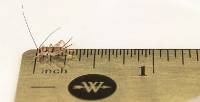Josh's Frogs
Why you should buy from us
Fleischmann's Glass Frog - Hyalinobatrachium fleischmanni (Captive Bred)
Fleischmann's Glass Frog - Hyalinobatrachium fleischmanni (Captive Bred)
$99.99 0.0 out of 5 stars
(0)
0.0 out of 5 stars
(0)About This Product
Defining Characteristics:
- Advanced
- Light green with small Yellow Spots
- See-through Belly
- Likes to Hide
- Moderate Care
- 1” Size
- A Single Quiet Peep
- Solitary or groups if space is provided
Name: Hyalinobatrachium Fleischmanni, Fleischmann's Glass Frog, Northern Glassfrog, and the San Jose glass frog. The genus name hyalinobatrachium roughly translates into crystal frog in Greek.
Recommended Vivarium Size: Fleischmann's Glass frog is very arboreal so a male and female pair should live in a 20 gallon or an 18x18x24 front opening tank. These frogs will need a lot of vegetation in their tanks to feel comfortable as they are fairly shy during the day. A water dish of clean water should be provided for these frogs at all times. Either biobedding or ABG topped with sphagnum should be provided for substrate. For Breeding conditions, a water feature with moving water is required to stimulate breeding.
Temperature: 72-78F
Humidity: 50-70%
Size: Males are ¾ ” and females are slightly larger at just under 1.” At time of sale these frogs will be at least 1/2" in length.
Age: Fleischmann's Glass frog can live for about 5-8 years but may live longer with ideal care.
Feeding: As adults Glass frogs can eat ⅛ ” crickets and Hydei Fruit flies. They will also be fed similarly sized insects. Young Fleischmann's Glass frogs can eat pinhead crickets and melanogaster fruit flies.
Sexing: Male Fleischmann’s Glass frogs will be slightly smaller than females and emit advertisement calls. A male’s call is a light “wheet” but can also emit a “priiip” when it’s territory is invaded by another male.
Color/Pattern: Fleischmann's Glass frogs are light green with light yellow spots. Its underbelly is partially transparent with its internal organs covered by a white guanine sheet.
Social Behavior: Male Fleischmann’s Glass frogs are very territorial and will fight other males. It is advised that keepers keep only a male/female pair or a group that is female heavy unless a large amount of space is provided.
Breeding: These frogs will breed on leaves overhanging streams. They will lay clutches of about 35 eggs at a time. Parents are fairly protective of their eggs and will sit near the egg clutch and fend off predators that try to eat the tadpoles and males will release bladder water onto the clutch to prevent desiccation.
Development: Eggs are laid on the underside of leaves and take approximately 2 weeks to hatch. Tadpoles will fall into the water below after hatching.
Tadpoles: Tadpoles may need moving water to thrive as they are typically found in streams. They will readily eat a variety of fish foods including Josh’s Frogs Tree Frog tadpole food. Tadpoles are known to partially bury themselves in the substrate for a time before becoming more visible later in development.
Natural Range: It is the centrolénido with the widest range of distribution. It is distributed in low and medium elevations from Mexico (Guerrero and Veracruz) to the provinces of Los Ríos and Guayas in Ecuador, passing through the Colombian and Ecuadorian Chocó, Panama, Central America and Suriname. In Ecuador, it is found in the low foothills of the western Andes mountain range. (Amphibiaweb)
Shipping
After placing an order containing a live animal, you will receive a scheduling email containing our JotForm scheduling link to schedule your new pet's delivery date.
With this scheduling link, you will be able to schedule your order's delivery up to 30 days in advance. You will be able to choose a date of delivery for Tuesday-Saturday (Saturday arrival depends on the carrier's service availability) with the estimated time of arrival generally being 12pm, or 4:30pm for more rural areas. Overnight lows must be above 40°F to ship directly to you (or above 30°F for FedEx Ship Center pickups) as well as below 90°F by estimated time of arrival.
If you require further assistance, or prefer to talk to one of our Customer Service agents, please feel free to reach out to our [email protected] email or our phone line 1-800-691-8178.
Customer Reviews
0.0 out of 5 stars
Review data
5 star reviews
- 0%
4 star reviews
- 0%
3 star reviews
- 0%
2 star reviews
- 0%
1 star reviews
- 0%


